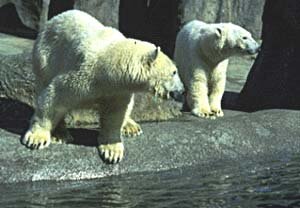
 Polar Bear
Polar Bear
scientific name
Ursus maritimus
size
Weight: male 770-1430+ lbs.; female 385-660+ lbs.
Height: standing, male to 11'; female 6-8'
adaptations/colorations
Color: white or yellowish; white serves as camouflage
Body. heavy layers of blubber up to 4" thick; provides insulation & buoyancy
Ears. small (less heat loss)
Feet. heavily furred to insulate & provide traction on ice (also allows very quiet movement); large; partially webbed (good oars)
Fur. thick
Hair: transparent, hollow, & conducts solar energy to black (mottled) skin
Smell: good (for hunting)
Swim: can swim 43+ mi. per day
Vision:. keen
Environment: white=camouflage; extremely well adapted to cold/aquatic
behavior
Den: don't den up (except pregnant females) as do most northern climate bears; males may den up if weather extremely severe
Migration: seasonal; follow food supply; can range up to 2000 mi. in 1 yr.
Personality: solitary except during breeding season or females with cubs; occasionally congregate at exceptional food source, such as whale/walrus carcass, or at start of ice flow (like Churchill)
Populations. maintain distinct population within distinct territories
Storms. don't like the wind because it is dehydrating " will avoid if possible
reproduction/lifespan
Lifespan: 25-30 years; maximum 33 years
Sexual Maturity. female 4-5 years; male 5-6 years
Mate. wild April - June; captivity February - June
Implantation. delayed
Gestation. ~8 mos.
Cubs. 1 - 3; 10" long; 21-25 oz; born December - January in captivity; leave den April (17-24 lbs.); remain with mother 28-40 months; mothers milk rich (31% butterfat) " cubs grow quickly reaching 70-100 lbs.in their first year
diet
Wild. primary food is ringed seals (2nd is bearded seals), harp seals, hooded seals, & walrus & whale carcasses when available; in summer, also eat berries, crabs, plants, small rodents, seaweed, starfish, sea cucumbers, etc.
Zoo. omnivore chow, fish (trout), carrots, apples, steelhead, bones, & vitamin oil
habitat/range
sea ice/waters; islands; coasts of Arctic Ice Cap " prefer ice that is periodically fractured by sea currents where seals are abundant
status
CITES App II; limited hunts still allowed; Canada, Denmark (Greenland), Finland, Norway, Russia, & U.S. pooling knowledge & keeping eye on status; major oil spill could devastate population by killing seals, their main food
oregon zoo exhibit